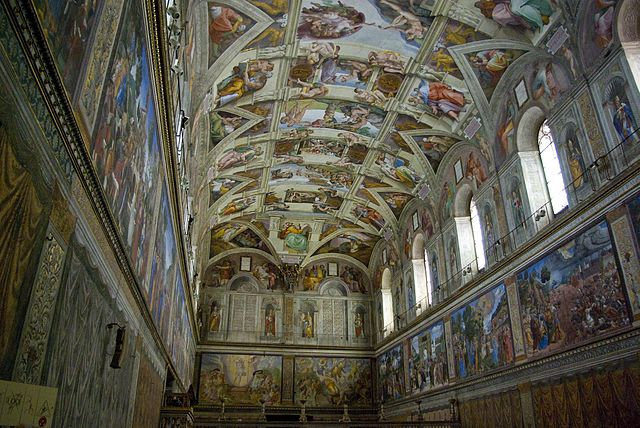*Image Credit: Wikimedia Commons After nine years’ worth of work by some of the most renowned artists and architects in history, the Sistine Chapel opened its doors for its first mass on August 9, 1483 of the Gregorian calendar. (August 15th on the Julian version in place at the time.) From 1473-81, Pope Sixtus IV commissioned architects to restore the former Capella Maggiore (Greater Chapel) in the Apostolic Palace. Once the reconstruction efforts were far enough along, the Bishop of Rome brought in Pietro Perugino, Sandro Botticelli, Domenico Ghirlandaio and a host of other well-respected painters to create a series of frescoes depicting the lives of Moses and Jesus above official papal portraits. The old church instantly rivaled St. Peter’s Basilica as the best-known cathedral in the world when the Pope consecrated and dedicated it to the Virgin Mary during the Feast of the Assumption. Dating to at least 1368, the Capella Maggiore had fallen into disrepair by the time Pope Sixtus IV took office in 1471. A letter from Andreas of Trebizond indicates the walls were leaning in on themselves, a sorry state for a place which held some 27 masses per year. Within two years, Pope Sixtus IV had brought in Baccio Pontelli to create a new design from the ground up. Working with lead builder Giovannino de Dolci, Pontelli used the Capella Maggiore’s footprint as inspiration for the new structure, keeping the dimensions as close to those of the original as possible. Over the course of eight years, the two slowly erected a magnificent structure to fit within the confines of tiny Vatican City. Stretching 134 ft long by 44 feet wide to match the dimensions of the ancient Temple of Solomon in Jerusalem, the Sistine Chapel is extensively buttressed along the exterior to support a roof nearly 70 feet overhead – a precaution against the deterioration which befell the Capella Maggiore. On the inside, the walls are divided into three individual levels, with the bottom simple frescoes painted to resemble tapestries, the second featuring scenes from the story of Moses and that of Jesus and the third featuring images of the popes. In order to ensure the quality of the works, Pope Sixtus IV contracted with Perugino immediately and sent word to Botticelli, Ghirlandaio and Cosimo Roselli that he wished to have them join their fellow Florentine in covering the walls in masterpieces befitting Holy Mother Church. Leaving Florence in October 1480, the caravan of artists is now regarded as a sort of gift from Lorenzo de Medici to smooth tensions between he and the Pope. The following spring, the four masters and their assistants got to work. Once the renovation was completed, the Sistine Chapel (Capella Sistina in Italian) restored an air of dignity to the proceedings within its walls – but its famous ceiling and approximately a third of the upper tier of the walls had been left blank. Twenty-five years later, at the urging of Pope Julius II, Michelangelo Buonarroti took on the task of filling them in with nine scenes from the Bible and images of Jesus’ ancestors. Far more famous than the frescoes painted by his predecessors, Michelangelo’s greatest work was completed in 1512.
August 9, 1483 CE – The Sistine Chapel Opens for Mass
*Image Credit: Wikimedia Commons After nine years’ worth of work by some of the most renowned artists and architects in history, the Sistine Chapel opened its doors for its first…
773
